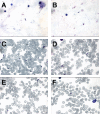A comparison of the sensitivities of detection of Plasmodium falciparum gametocytes by magnetic fractionation, thick blood film microscopy, and RT-PCR
- PMID: 19432971
- PMCID: PMC2689255
- DOI: 10.1186/1475-2875-8-98
A comparison of the sensitivities of detection of Plasmodium falciparum gametocytes by magnetic fractionation, thick blood film microscopy, and RT-PCR
Abstract
Background: The magnetic properties of Plasmodium-infected erythrocytes have been exploited for different clinical and research purposes. A recent study in a rural clinical setting in Papua New Guinea has demonstrated that Plasmodium falciparum gametocyte detection is facilitated by magnetic deposition microscopy but no study has yet determined the relative sensitivity and limit of detection of a magnetic fractionation technique. The present study compares the detection limit and sensitivity of a technique based on the use of commercially available magnetic fractionation columns with those for thick blood film microscopy and reverse transcriptase polymerase chain reaction (RT-PCR) methods.
Methods: Gametocyte detection in six series of dilutions of cultured P. falciparum parasites with known gametocytaemia was conducted using magnetic fractionation, thick blood film, and RT-PCR techniques.
Results: The preparations obtained by the magnetic fractionation method were of thin film quality allowing easy gametocyte identification by light microscopy. Magnetic fractionation had a higher sensitivity and approximately two orders of magnitude better limit of detection than thick blood film microscopy. Gametocytes were also more readily detectable on the magnetically fractionated preparations. Magnetic fractionation had a similar limit of detection to that of RT-PCR.
Conclusion: Magnetic fractionation is a highly sensitive and convenient method for gametocyte detection in comparison with the standard thick blood film and RT-PCR methods, and could readily be adapted to field application.
Figures




Similar articles
-
Short report: Quantification of Plasmodium falciparum gametocytes by magnetic fractionation.Am J Trop Med Hyg. 2011 Jan;84(1):158-60. doi: 10.4269/ajtmh.2011.10-0416. Am J Trop Med Hyg. 2011. PMID: 21212220 Free PMC article.
-
Enhanced detection of gametocytes by magnetic deposition microscopy predicts higher potential for Plasmodium falciparum transmission.Malar J. 2008 Apr 25;7:66. doi: 10.1186/1475-2875-7-66. Malar J. 2008. PMID: 18439240 Free PMC article.
-
Comparison of three methods for detection of gametocytes in Melanesian children treated for uncomplicated malaria.Malar J. 2014 Aug 14;13:319. doi: 10.1186/1475-2875-13-319. Malar J. 2014. PMID: 25123055 Free PMC article.
-
Development of a reverse transcription-loop-mediated isothermal amplification (RT-LAMP) for clinical detection of Plasmodium falciparum gametocytes.Parasitol Int. 2010 Sep;59(3):414-20. doi: 10.1016/j.parint.2010.05.008. Epub 2010 Jun 10. Parasitol Int. 2010. PMID: 20542143
-
Molecular approaches to monitor parasite genetic complexity in the transmission of Plasmodium falciparum malaria.Parassitologia. 2005 Jun;47(2):199-203. Parassitologia. 2005. PMID: 16252474 Review.
Cited by
-
Seasonal variations in Plasmodium falciparum parasite prevalence assessed by varying diagnostic tests in asymptomatic children in southern Ghana.PLoS One. 2018 Jun 15;13(6):e0199172. doi: 10.1371/journal.pone.0199172. eCollection 2018. PLoS One. 2018. PMID: 29906275 Free PMC article.
-
Mobile phone imaging and cloud-based analysis for standardized malaria detection and reporting.Sci Rep. 2016 Jun 27;6:28645. doi: 10.1038/srep28645. Sci Rep. 2016. PMID: 27345590 Free PMC article.
-
Direct transfer of HRPII-magnetic bead complexes to malaria rapid diagnostic tests significantly improves test sensitivity.Malar J. 2016 Aug 5;15(1):399. doi: 10.1186/s12936-016-1448-6. Malar J. 2016. PMID: 27495329 Free PMC article.
-
Gametocyte Clearance Kinetics Determined by Quantitative Magnetic Fractionation in Melanesian Children with Uncomplicated Malaria Treated with Artemisinin Combination Therapy.Antimicrob Agents Chemother. 2015 Aug;59(8):4489-96. doi: 10.1128/AAC.00136-15. Epub 2015 May 18. Antimicrob Agents Chemother. 2015. PMID: 25987625 Free PMC article.
-
Parameterization of high magnetic field gradient fractionation columns for applications with Plasmodium falciparum infected human erythrocytes.Malar J. 2010 May 3;9:116. doi: 10.1186/1475-2875-9-116. Malar J. 2010. PMID: 20433771 Free PMC article.
References
-
- Carter RGR. In: Infectiousness and gamete immunization in malaria. In: Research in Malaria. J K, editor. Vol. 3. AcademicPress; 1980. pp. 263–298.
-
- Schneider P, Bousema JT, Gouagna LC, Otieno S, Vegte-Bolmer M van de, Omar SA, Sauerwein RW. Submicroscopic Plasmodium falciparum gametocyte densities frequently result in mosquito infection. Am J Trop Med Hyg. 2007;76:470–474. - PubMed
-
- Hackett S, Hamzah J, Davis TM, St Pierre TG. Magnetic susceptibility of iron in malaria-infected red blood cells. Biochim Biophys Acta. 2009;1792:93–99. - PubMed
-
- Nalbandian RM, Sammons DW, Manley M, Xie L, Sterling CR, Egen NB, Gingras BA. A molecular-based magnet test for malaria. Am J Clin Pathol. 1995;103:57–64. - PubMed
Publication types
MeSH terms
Substances
LinkOut - more resources
Full Text Sources
Other Literature Sources
Medical

